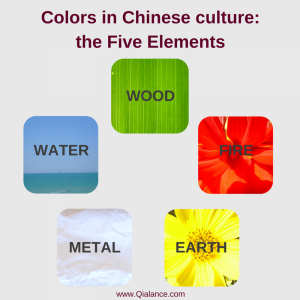Colors in Chinese culture and the Five Elements
This post is a little unusual for my blog. Because it is not about Taijiquan or Qi Gong directly. But I really like to learn more about China and Chinese traditions, so I got into colors in Chinese culture.
To understand Chinese color meanings, let’s start with the Five Elements (Wu Xing):

Wood, Fire, Earth, Metal, and Water. The Five Elements are bascially used for describing interactions and relationships between phenomena. Think about nature: Spring (Wood), Summer (Fire), late Summer (Earth), Autumn (Metal), and Winter (Water). That’s just the natural evolvement of the seasons. And in Chinese medicine, everything (e.g. organs, body parts, emotions, senses) is connected with one of the Five Elements.
And of course, each Element is assigned a color!
Thus when you know the Five Elements, you can imagine at least some of the meaning of the colors in Chinese culture.
Colors in Chinese culture
Just look at green (青 qing), the color of the Wood element, connected with spring. Isn’t spring a wonderful time to grow and expand? Thus the color green is generally associated with health, prosperity, and harmony.
Or for example red (红 hong), the color of the Fire element. It’s the time of summer, the time of joy & happiness – that’s the meaning of the color red in Chinese! Red is the Chinese good luck color. It also stands for celebration, vitality, and it is the bridal color. Well, in the West we associate love with the color red, in China pink or purple is the color of love and romance
Yellow (黄 huang) is corresponding with the element Earth. Think about late summer, when everything is glowing, like that yellow-orange Indian summer. In China, yellow is considered the most beautiful and prestigious color. It signifies neutrality and good look. Maybe you know the traditional Chinese book about medicine, the “Huang Di Nei Jing”. Huang Di is the Yellow Emperor! And as yellow and gold are very familiar, gold stands for wealth and riches.
However, yellow is nowadays often associated with pornography! I think that’s quite strange, but symbolism changes over time and surely is not logical.
White (白 bai) is the color of the element Metal. On one side it symbolizes brightness, purity, intuition, and fulfillment. On the other side, it is also the color of mourning and ghosts. Thus if you go to a Chinese funeral expect a lot of people wearing white clothes (red, on the other side, is not allowed at Chinese funerals)!
The element Water is connected to black (黑 hei) or blue (蓝 lan). Blue is the color of healing, relaxation, trust, calmness, and immortality. Just think of the ocean, isn’t that calming you already?
Black is a more neutral color, it could be associate stability, adaptability, and will. But is it also used for dark, evil, and sinister. And of course Black and White are used in the Taiji symbol to represent Yin and Yang.
Now you have an idea of the Five Elements, their associated colors, and the colors in Chinese culture. Obviously one could get much deeper into this, so if you are interested, I’d recommend continue reading here, here or here.
Happy Qi!
Angelika
